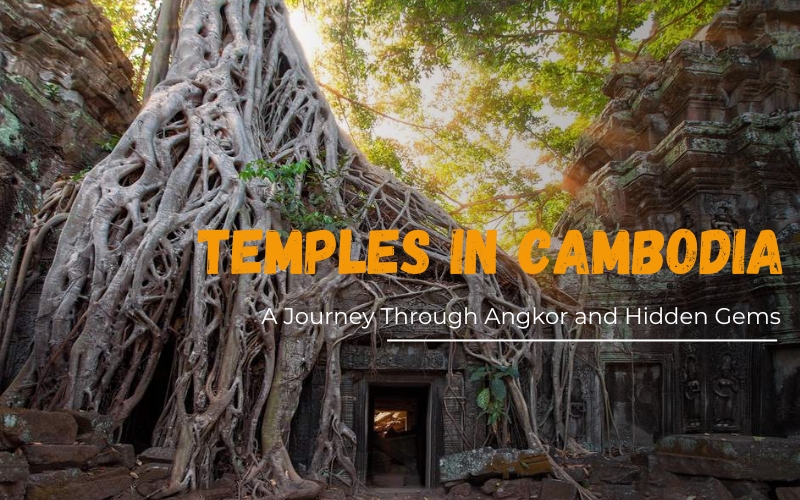
Cambodia is a country with a long and rich Buddhist culture. Temples in Cambodia are not only places of worship and rituals but also preserve the historical, cultural and spiritual values of the Cambodian people. This guide highlights the most beautiful temples in Cambodia, reveals their historical significance, provides insider travel tips and ensures you have the best experience. Let’s explore the wonders of Cambodian temples together!
Historical and cultural significance of temples in Cambodia
Cambodia’s culture and traditions have a rich and diverse history that spans centuries. Religion plays a large role in cultural activities and is an integral part of Cambodian life. This is evident in the architecture of the temples and pagodas throughout Cambodia, the most famous of which is the Angkor complex. The temples are a lasting testament to the country’s glorious past, reflecting the splendor and sophistication of the ancient Khmer civilization.
The temples were originally built for religious purposes, to worship the gods, and later transformed into important pilgrimage sites. The massive stone structures and meticulously carved reliefs tell epic Hindu and Buddhist stories, historical events and daily life, allowing visitors to witness vivid depictions of the rituals, battles and celebrations of past dynasties. Each temple reflects its own unique artistic style and historical stories. Therefore, visiting Cambodia’s temples offers visitors a fascinating journey through history, culture and spirituality, helping them gain a deeper understanding and appreciation of Southeast Asian heritage.
> > > If you’re captivated by the timeless beauty of its temples and eager to experience their wonders firsthand, our carefully crafted Cambodia tours will guide you through the country’s most spectacular historical sites and hidden gems, ensuring an unforgettable journey.
Best temples to visit in Cambodia
Angkor Wat
Angkor Wat is a UNESCO World Heritage Site and the pride of the Cambodian people. It was built around the beginning of the 12th century. The architecture and carvings of Angkor Wat are a combination of Hinduism and Buddhism. This partly reflects the religious and cultural diversity of Cambodia.
Built with extremely impressive architecture, this temple is not only an architectural work but also a true work of art. The special feature of Angkor Wat is the main entrance facing the West towards the rising sun, symbolizing rebirth and eternity. Inside the temple are 398 rooms connected to each other through 1,500 meters of corridors. Above, Angkor Wat stands out with 5 towers, of which the central tower is 65 meters high, creating a majestic picture of the sky and land.
But not only architecture, Angkor Wat also contains the secrets of ancient Khmer art. From the giant reliefs to the intricately carved stone pillars, every detail reflects the sophistication and craftsmanship of the carvers of the time. Every wall, every corridor, and every stone pillar tells a story about the history and culture of Cambodia at that time.
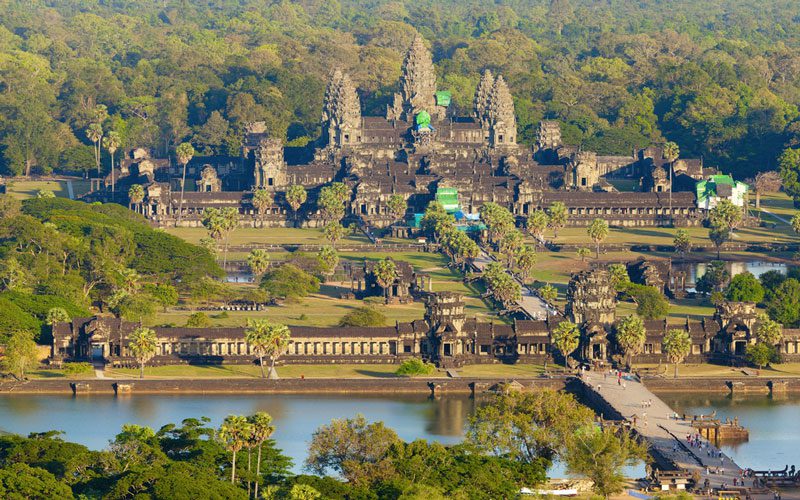
Angkor Wat
Angkor Thom (Bayon Temple)
Angkor Thom means “Great City”, and is one of the most prominent structures of the Angkor complex. Built in the late 12th century under the reign of King Jayavarman VII, Angkor Thom covers an area of about 9 km² and was the last capital of the Khmer Empire. This is a powerful royal city, containing palaces, temples and a solid defense system.
Known for its 200 giant stone faces, Bayon Temple is not only an architectural work but also a vivid work of art. The faces have a mysterious and profound beauty, likened to the “Mona Lisa of Southeast Asia”. The temple is designed as a giant square, surrounded by a 12 km long wall and a deep moat. There are four main gates leading to the city: South Gate, North Gate, East Gate and West Gate, each gate has 4 giant stone faces guarding the gate. Among them, the South Gate of Angkor Thom is the most popular tourist destination, because of its unique beauty and giant statues lining both sides of the road leading to the gate.
> > > To truly experience Cambodia’s temple treasures, joining an Angkor tour is the perfect gateway to discovering the magic, history, and hidden gems of this ancient kingdom.
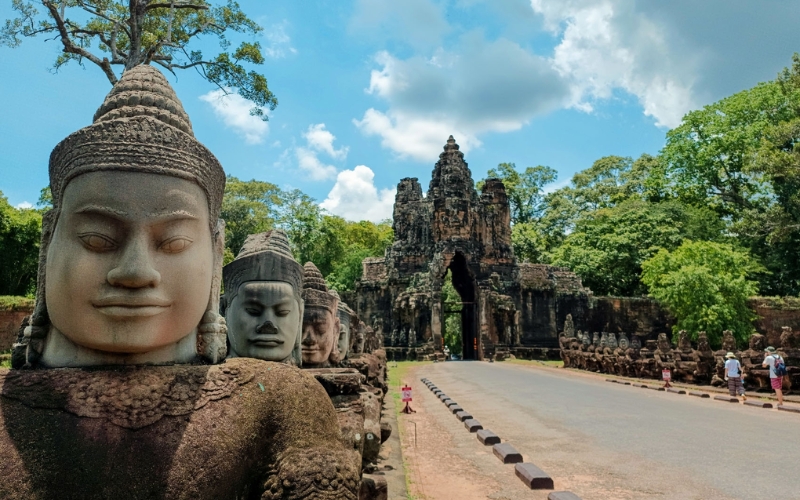
The South Gate is the most popular for tourists when coming to Angkor Thom
Ta Prohm
Known as the “ancient temple”, Ta Prohm is surrounded by ancient trees with large, thick and long roots, creating a vivid and magical picture. Built in 1186 under the reign of King Jayavarman VII, Ta Prohm is not only an architectural work but also a cultural and spiritual symbol. During its heyday, this temple was home to more than 12,500 people, including priests and Khmer people. They lived and served here, contributing to the maintenance and protection of this sacred temple.
However, after the collapse of the Khmer empire in the 15th century, Ta Prohm was abandoned. Time and nature have turned it into a part of the rainforest with giant ancient trees taking over and surrounding it. Today, Ta Prohm is not only a cultural heritage but also an attractive tourist destination, attracting millions of visitors from all over the world to visit and admire.
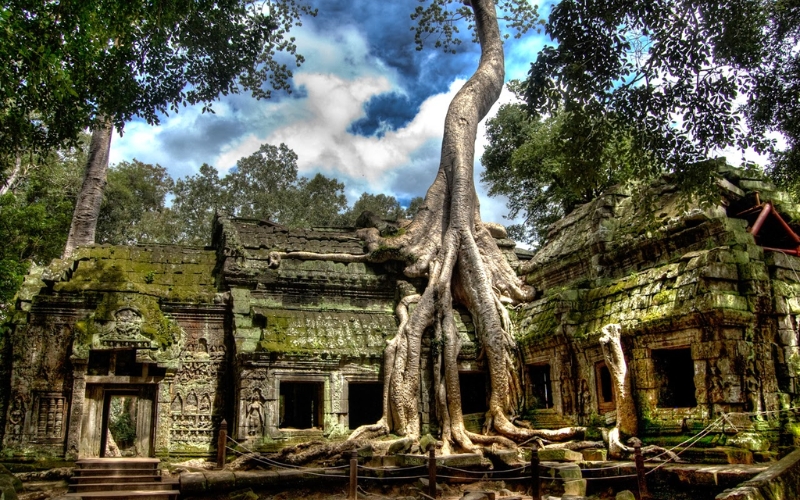
Over time the temple was covered with giant ancient trees
Banteay Srei
This ancient temple in the Angkor Thom complex was built to worship the supreme god Shiva in Hinduism. It is also known as the temple for nuns because the deep meaning of the name Banteay Srei is the stronghold of women. During the Angkor era, the ancient temple became the residence of female warriors.
Located far from the main temples, Banteay Srei is one of the smallest temples in Angkor but still attracts many visitors with its sophisticated carvings. The temple is built from smooth pink sandstone, the temple walls are elaborately decorated with floral motifs and the story of Ramayana. The entire temple is the pinnacle of stone art with delicate and skillful reliefs. Each wall and each sculpture in Banteay Srey contributes to telling a unique story.
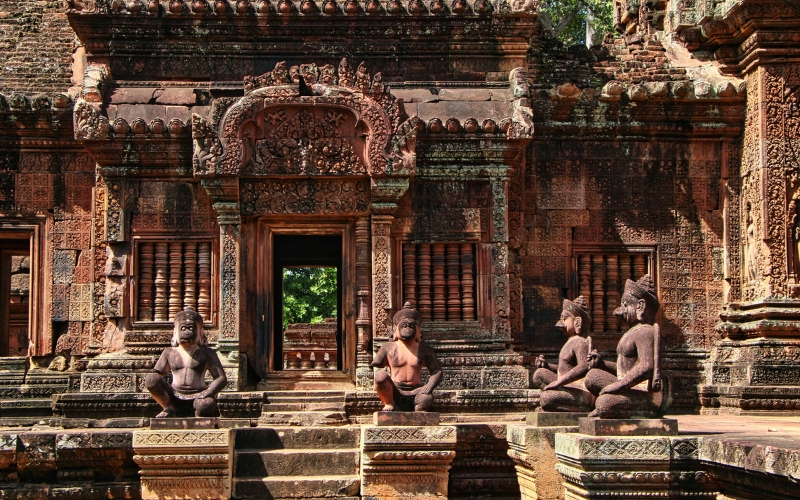
Banteay Srei still retains intact statues and wall sculptures
Wat Phnom
Wat Phnom, also known as Wat Penh, is a historic and sacred temple in the capital Phnom Penh, Cambodia. Built in 1373 on a 27-meter-high artificial hill, the highest point in the city, it is a cultural and spiritual symbol of Phnom Penh, Cambodia. Considered the spiritual heart of the city, Wat Phnom is not only a sacred place of worship but also a witness to the history of Phnom Penh’s formation.
Wat Phnom is built in the classical Khmer style, featuring tall, pointed pagoda towers with elaborate carvings. The temple has a spacious, solemn space with many shrines and large Buddha statues. Around the temple are meticulously carved patterns on the walls, telling Cambodian folk tales and legends. Along the entrance are statues of sacred animals and dragons, symbolically protecting and leading you closer to the spiritual world.
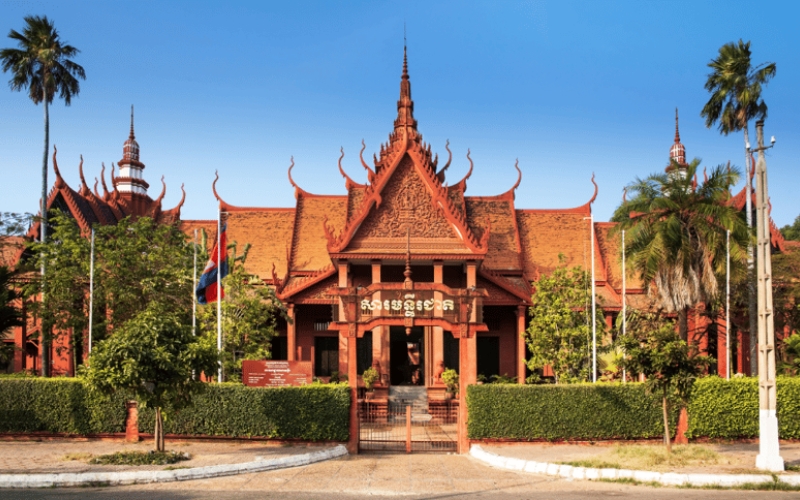
Wat Phnom is a sacred temple in Phnom Penh
Golden & Silver Temple
Wat Preah Keo Morakot is also known as the Golden Temple – Silver Temple. The name of this temple comes from the main Buddha statue inside, which is made from precious emeralds, which Cambodians call Keo Morakot, and from the floor of the temple, which is paved with 5,329 silver tiles. From afar, the temple exudes splendor and majesty with its bright yellow and red tiled roof. The temple’s architecture is solemn and bears the traditional Khmer imprint, blending in with the sophisticated style of Angkorian architecture.
The temple has 1,650 works of art, most of which are Buddha statues made of gold, silver, bronze and other precious materials. Some are even studded with diamonds. They were gifts from the king, the royal family, the wealthy and other classes. The most prominent are an emerald Buddha statue and a Maitreya Buddha statue cast from 90kg of pure gold and studded with 9,584 diamonds. The temple is where the king performs rituals and listens to Buddhist teachings. This is also where the Cambodian royal family holds annual Buddhist ceremonies.

Silver Pagoda in Phnom Penh
Preah Vihear
Preah Vihear Temple in Cambodia is known as the “temple of temples” and is a UNESCO World Heritage Site. The temple stretches 800m from the foot of the mountain to the top along the North-South axis and was built in the 9th century, worshiping Shiva – the god of destruction and creation in Hindu mythology. The temple was continuously completed and rebuilt over many centuries, through about 7 kings of the old Khmer empire.
The architecture of Preah Vihear Temple is designed in a stepped style, highlighted by long paths leading to the worshiping rooms and main shrines. Preah Vihear Temple impresses visitors with its exquisite sculptures and reliefs, depicting Hindu legends and symbols. Currently, the main shrine area has been renovated to become a Buddhist worshiping place with monks always on duty to bless visitors or Buddhists who come to visit.
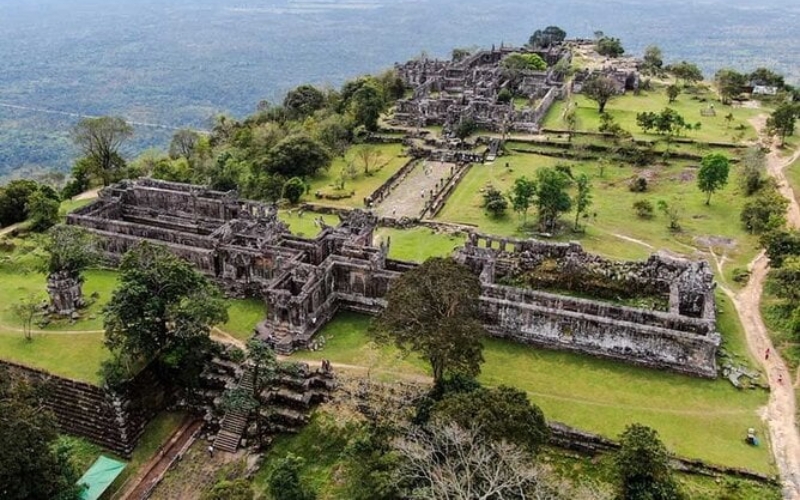
Preah Vihear from above
Phnom Bakheng
Phnom Bakheng, a Hindu temple in the form of a mountain temple, was built in the late 9th century, serving as the center of a new empire under King Yasovarman. Phnom Bakheng was built about 2 centuries before Angkor Wat and was the main temple of this temple. Phnom Bakheng is also known as a symbolic landmark of Mount Meru, the abode of Hindu gods. The temple is located on top of a steep hill 65 meters above the surrounding plain. In addition, the temple here is also built in the shape of a pyramid with seven floors symbolizing the seven heavens.
When completed, Phnom Bakheng has 108 small towers spread around the temple on the ground and on the floors. Standing on the top of the hill, you will admire the surreal sunset scene in the sky of Angkor. The brilliant beauty of the sunset falling on this land seems to bring impressive scenes with mysterious colors worth exploring.
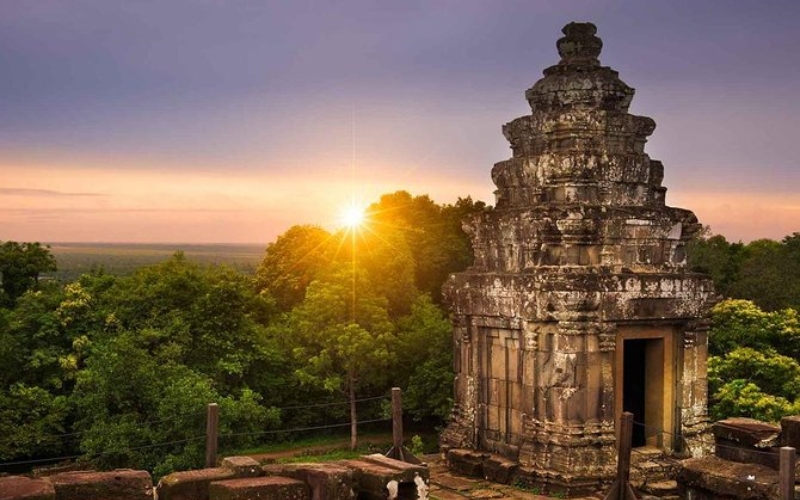
Phnom Bakheng attracts many tourists to admire its beautiful sunrise scene
Travel tips for temple explorations in Cambodia
When planning to explore Cambodia’s beautiful temples, being well-prepared can greatly enhance your experience. Here are some helpful tips:
- When visiting temples, dress modestly, avoiding revealing or short clothing. Since you will be doing a lot of walking or climbing, bring comfortable shoes or sturdy sandals.
- When visiting temples, visitors should not touch the Buddha statues on display. Also, remember to keep the temple clean and protect the temple’s common property.
- Plan your visit to make the most of your time. Early morning is the ideal time to admire the beauty of the temples. Before sunrise, the scenery here becomes more mysterious and magical, as if transporting you to a magical land.
- Hiring a knowledgeable local guide will greatly enrich your temple visit. Guides provide historical context, explain carvings and reliefs, explain cultural symbols, and reveal hidden details you might otherwise miss. They can also steer you away from crowded areas and help you plan an efficient itinerary that will help you make the most of your time at key sites.
- A motorbike taxi is the best option if you want to save the most money on your temple trip. And if you’re traveling in a group or want to try a new mode of transportation at a reasonable price, a tuk-tuk is the perfect option.
With this inspiring list of the most beautiful temples in Cambodia, you are now ready to experience firsthand the beauty, culture and history of the legendary Khmer civilization. Whether you are captivated by the majestic sunrises at Angkor Wat, mesmerized by temples hidden in the jungle or mesmerized by intricate carvings depicting ancient stories, Cambodia’s temples promise to give you unforgettable experiences.
Read more:

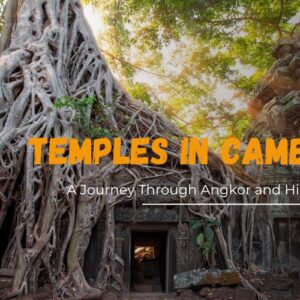



This post is amazing! I’m really into photography and your shots are inspiring. Did you use a local guide who knows good photo spots or did you explore on your own? Also, were drones allowed at any of these temples?
Thank you so much for your kind words! Cambodia’s temples are a dream for photography lovers. For most of the shots, we did explore with a local guide, which helped a lot in finding those quieter, less-crowded angles and hidden corners. They know the best times for lighting too!
As for drones, it depends on the temple. Angkor Wat and major temples in the Angkor complex generally don’t allow drone flying without special permission from the APSARA Authority. Some smaller or more remote temples may be more flexible, but it’s always best to check locally or ask your guide. Let us know if you’re planning a trip—we’d be happy to help you organize something tailored for photography!
Best regards,
IDC Travel Team